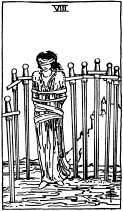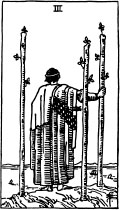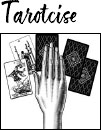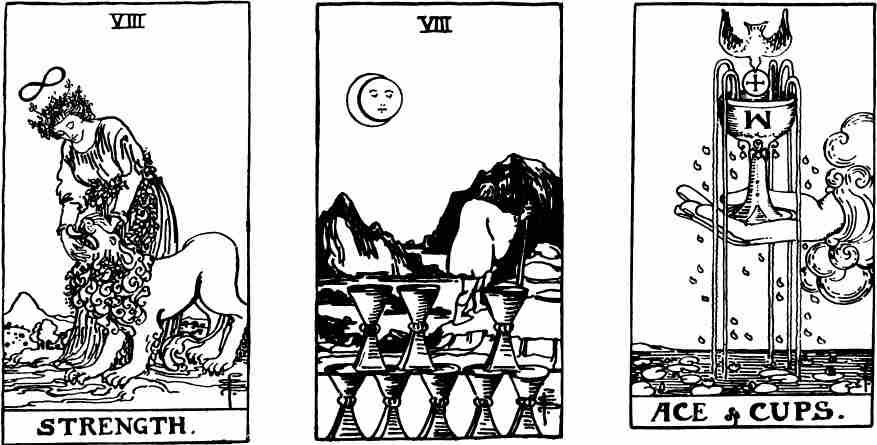
In this book, we only concern ourselves with three spreads:
Why?
In my opinion, these three are the best for intuitive readings as well as general outlooks. A general outlook is a reading done with little to no backstory from the client. The querent may want to know about the future or just get some general guidance. This type of reading requires a great deal of skill, practice, and confidence with your intuition. But don't sweat this! I'm going to walk you through each spread with sample readings.
For each reading, we'll do two different samples. The first one will be a specific question, and the second will be a general outlook.
Someone (I can't remember who) once said to me that one card contains all the information that you need. This person also said that you should be able to deliver a ton of guidance with just that one card. While that may seem like a mighty tall order (or challenge), there is some truth to this advice. Each card is rich in symbolism, and you can find plenty to work with for interpreting.
Let's start by using the one-card draw for a question. Sabine's daughter just got married. She's already talking about starting a family. Naturally, Sabine is excited at the prospect of becoming a first-time grandmother. Her question: “What can I expect when it comes to anticipating future grandchildren?” (I have to laugh at her clever way of avoiding a “will I” question.)
The card she pulled: Eight of Swords. The woman in the card is certainly not moving. She's wearing a blindfold and is bound. Sabine said, “I guess this means it's out of my control.” I agreed. I also noted that the answer is not here at this time, and the question about children might be more effective if her daughter were asking instead. Also, perhaps it is too soon to visit this question since her daughter just got married. Sabine will need to wait this out and not put pressure on her daughter. While this card may not seem like a positive one to see, it is tarot's way of reminding Sabine to remain focused on her own world rather than getting too nosy about her daughter's.


Now, let's do a general outlook, no question. Sabine chose the Three of Wands. This card shows a bright future and many possibilities on the horizon. My interpretation: “You're at the top of your game at this time. You've worked hard to get there. If you look at the present moment, you'll see that you are standing on a mountain of accomplishments. You'll also see that ships are sailing into view, a sign that new opportunities are on the way. Soon, you'll have a few good options to consider. Where do you want to go from here? What do you want to conquer next? Set your sights on your big, bold future, and know that everything is possible. If you're thinking about travel, this card promises more than one journey ahead.”
Sabine is currently at the peak of her career. She's in her mid-fifties and holds a high position in a corporate job. Travel is something on the docket for the next year, and much of it revolves around major career deals.
How did I get that? I just trusted my gut and let the card do the talking. Keep in mind that this is my interpretation. You may see other things for Sabine.
 Pull out the cards mentioned in these examples. What information might you give Sabine in either case? What are you seeing that I'm not? Journal your thoughts.
Pull out the cards mentioned in these examples. What information might you give Sabine in either case? What are you seeing that I'm not? Journal your thoughts.
One night after a lovely dinner in a Moroccan restaurant in the East Village, my friend Paige Zaferiou pulled out the tiniest tarot deck I have ever seen for some impromptu readings. This was great fun, and I said it was like an “after-dinner tarot mint.”
Since that time, I've always had a baby tarot deck with me for dinner-tainment and on-the-go tarot readings. I've been known to pull out the deck randomly while standing in line at the coffee shop or meeting strangers at a bar. Reading the cards spontaneously is a fantastic way to sharpen your skills and make connections. After all, everyone loves having their cards read!
At one such dinner, I began experimenting with a technique that is great fun . . . and revelatory. It's a way to add an extra element of oomph to a one-card spread; plus it brings people together. I call it my Round Robin Tarot Reading.
Here's how you do it:
You need four people. Any more than that, and the reading becomes unwieldy. Three can work, but two people aren't enough. I've found through experimentation that four is the ideal number.
One person shuffles the cards and then fans them out, facedown. Each person at the table draws one card. That person can choose a specific question or general advice. Once everyone has pulled a card, each person takes a turn, interpreting what they think their card means. The other people at the table can offer their interpretation too.
Next, one at a time, all the participants use all four cards to do a reading for themselves, starting with their card and going around the table to the left in the order they are sitting. For example, let's say I'm sitting at the table with Paige to my left, followed by Briana and Hilary. I'll start with my card, then read Paige's, and next Briana's, and finally Hilary's. This will be my reading with Hilary's card as my outcome.
Paige will then do her reading starting with her card, followed by Briana's, Hilary's, and mine will be last. And so on. What's interesting about the Round Robin Tarot Reading is that we all have unique interpretations, but once we add the other participants' cards with our own, the readings are uncanny.
After everyone is finished, I lay out the cards, and we do a reading for the world with the four cards chosen.
This technique is a playful twist on a one-card draw and a perfect way to end a night out with your besties!
The Past Present Future spread is an oldie but a goodie. Every tarot book on the market has this spread or some version of it. It's excellent for divination purposes and specific questions.
The way to do the spread: Shuffle the cards, focusing on the question or just keeping your mind open. Cut the cards into three piles and put them back together. Take three cards off the top of the deck and turn them over. The positions are Past, Present, and Future. You can look at them as a whole and interpret that way or use the positions.
Let's look at some examples. Xavier wants to see where his new relationship with Paul is heading. The cards he pulls: Nine of Wands, Five of Swords reversed, Queen of Cups.

Past: Nine of Wands—Xavier has been hurt before. He's coming into this relationship with a lot of baggage. The old scars have never been fully healed. He may even have unfinished business with an ex! His trust issues are massive, so his new relationship is going to have a rough start.
Present: Five of Swords reversed—I always interpret the Five of Swords as a card of hurt and deception. Reversed, it seems to say that the new partner is proving that he can be trusted. Paul is being honest and wants to keep the air as clean as possible. Perhaps he's aware that Xavier has trust issues and is being delicate. Or maybe he's looking to move forward and doesn't want Xavier's past to get in the way of a promising future.
Future: Queen of Cups—Speaking of the future, the Queen of Cups is a sweet card to see in a love reading. There is a possibility for a real, genuine heart connection here. Even if Xavier has reservations, Paul may be able to break through those old wounds and help Xavier learn to trust in love again. My feeling is that this relationship may have some challenges, but if they continue to work on building trust, it could become a profound, loving union.
Now, let's do a general outlook for Xavier.
The cards: Strength, Eight of Cups, Ace of Cups.

Past: Strength—Xavier has overcome a significant challenge. Something in his life felt difficult. It required him to rely on his inner strength more than ever before. In some way, this situation has forced him to deal with unpleasantness, but perhaps it made him stronger. The challenge is well behind him, and he's come out on top.
Present: Eight of Cups—He's moved on. The past is in the past. There are still some unresolved emotions, but he's left the challenge in search of something new. When I look at these two cards, I see a person who got sick of struggling and decided to walk away.
Future: Ace of Cups—A new beginning, new love, and the new emotional beginning are on the way. Xavier left a situation that was not working, and now he's about to embark on a new emotional journey, one that will be healing. New love is offered. Even if he thought he would be alone, this combination tells me that he won't. He has much to look forward to.
If we looked at these cards without relying on the positions, we might notice the two cards from the Cups suit and determine that a lot is happening in the client's sentimental life. The energy between these three cards shows a person on a journey to love or in the midst of an emotional rebirth.
Your turn!
 Pull out the cards that Xavier chose for each spread and contemplate your interpretations for the cards. How do they go together? What are the general themes? If you had to tell a story for each spread, what might the story be? Journal your thoughts and any advice you'd give Xavier.
Pull out the cards that Xavier chose for each spread and contemplate your interpretations for the cards. How do they go together? What are the general themes? If you had to tell a story for each spread, what might the story be? Journal your thoughts and any advice you'd give Xavier.
Now, using the same cards, let the first spread be a general outlook, and use the cards in the second spread for the question. What interpretations might you find when you change things around? Are things different? What themes are present in both readings? Does the future look different if you move the cards around?
In the second reading, read the cards from right to left as if you are telling the story backward. What does this tell you? How does the story look when you go back?
The Celtic Cross is one of the most popular tarot spreads. This ten-card layout packs a lot of punch and allows for a rich, detailed tarot reading. It can be used to get in-depth answers to a question. It's also useful for general outlooks because the positions create a trail of clues that can show where a querent has been and where they may be heading.
The Celtic Cross layout involves six cards in a cross formation and a vertical row of four on the right side of the cross (see the image on page 222).
There are variations on how the cards should be laid out—often with positions 3 and 5 reversed. In my opinion, the way that makes the most sense is to place position 3 on the bottom and lay 4, 5, and 6 clockwise around the mini-cross in the middle.
Here's how to lay out the Celtic Cross and a brief description of what each position means:
When you lay out the cards in this formation, you'll see that position 3 as the foundation makes sense. As you move clockwise around the mini-cross, a story unfolds from the past influences toward the likely outcome. It's fluid and reads well.
Some readers will pick a significator to represent the querent before they shuffle the cards. This is a matter of personal preference. I don't do this because I believe that the energy the person is manifesting at the time of the reading will show up in the reading. (More on significators in the “Fine-Tuning Your Intuitive Tarot Readings” chapter.)